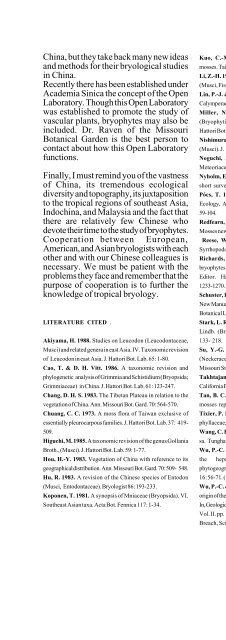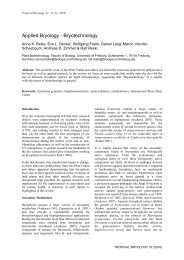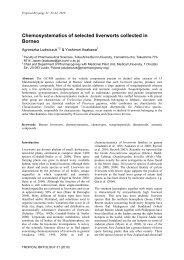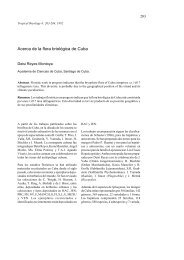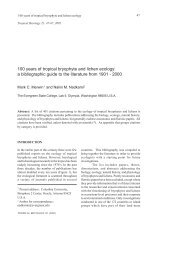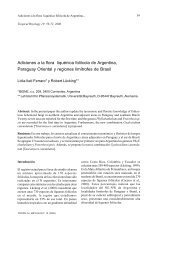Tropical component of the Moss Flora of China
Tropical component of the Moss Flora of China
Tropical component of the Moss Flora of China
Create successful ePaper yourself
Turn your PDF publications into a flip-book with our unique Google optimized e-Paper software.
<strong>China</strong>, but <strong>the</strong>y take back many new ideas<br />
and methods for <strong>the</strong>ir bryological studies<br />
in <strong>China</strong>.<br />
Recently <strong>the</strong>re has been established under<br />
Academia Sinica <strong>the</strong> concept <strong>of</strong> <strong>the</strong> Open<br />
Laboratory. Though this Open Laboratory<br />
was established to promote <strong>the</strong> study <strong>of</strong><br />
vascular plants, bryophytes may also be<br />
included. Dr. Raven <strong>of</strong> <strong>the</strong> Missouri<br />
Botanical Garden is <strong>the</strong> best person to<br />
contact about how this Open Laboratory<br />
functions.<br />
Finally, I must remind you <strong>of</strong> <strong>the</strong> vastness<br />
<strong>of</strong> <strong>China</strong>, its tremendous ecological<br />
diversity and topography, its juxtaposition<br />
to <strong>the</strong> tropical regions <strong>of</strong> sou<strong>the</strong>ast Asia,<br />
Indochina, and Malaysia and <strong>the</strong> fact that<br />
<strong>the</strong>re are relatively few Chinese who<br />
devote <strong>the</strong>ir time to <strong>the</strong> study <strong>of</strong> bryophytes.<br />
Cooperation between European,<br />
American, and Asian bryologists with each<br />
o<strong>the</strong>r and with our Chinese colleagues is<br />
necessary. We must be patient with <strong>the</strong><br />
problems <strong>the</strong>y face and remember that <strong>the</strong><br />
purpose <strong>of</strong> cooperation is to fur<strong>the</strong>r <strong>the</strong><br />
knowledge <strong>of</strong> tropical bryology.<br />
LITERATURE CITED .<br />
Akiyama, H. 1988. Studies on Leucodon (Leucodontaceae,<br />
Musci) and related genera in east Asia. IV. Taxonomic revision<br />
<strong>of</strong> Leucodon in east Asia. J. Hattori Bot. Lab. 65: 1-80.<br />
Cao, T. & D. H. Vitt. 1986. A taxonomic revision and<br />
phylogenetic analysis <strong>of</strong> Grimmia and Schistidium (Bryopsida;<br />
Grimmiaceae) in <strong>China</strong>. J. Hattori Bot. Lab. 61: 123-247.<br />
Chang, D. H. S. 1983. The Tibetan Plateau in relation to <strong>the</strong><br />
vegetation <strong>of</strong> <strong>China</strong>. Ann. Missouri Bot. Gard. 70: 564-570.<br />
Chuang, C. C. 1973. A moss flora <strong>of</strong> Taiwan exclusive <strong>of</strong><br />
essentially pleurocarpous families. J. Hattori Bot. Lab. 37: 419-<br />
509.<br />
Higuchi, M. 1985. A taxonomic revision <strong>of</strong> <strong>the</strong> genus Gollania<br />
Broth., (Musci). J. Hattori Bot. Lab. 59: 1-77.<br />
Hou, H.-Y. 1983. Vegetation <strong>of</strong> <strong>China</strong> with reference to its<br />
geographical distribution. Ann. Missouri Bot. Gard. 70: 509- 548.<br />
Hu, R. 1983. A revision <strong>of</strong> <strong>the</strong> Chinese species <strong>of</strong> Entodon<br />
(Musci, Entodontaceae). Bryologist 86: 193-233.<br />
Koponen, T. 1981. A synopsis <strong>of</strong> Mniaceae (Bryopsida). VI.<br />
Sou<strong>the</strong>ast Asian taxa. Acta Bot. Fennica 117: 1-34.<br />
Kuo, C.-M. & T.-Y. Chiang. 1987. Index <strong>of</strong> Taiwan<br />
mosses. Taiwania 32: 119-207.<br />
Li, Z.-H. 1985. A revision <strong>of</strong> <strong>the</strong> Chinese species <strong>of</strong> Fissidens<br />
(Musci, Fissidentaceae). Acta Bot. Fennica 129: 1-65.<br />
Lin, P.-J. & W. D. Reese. 1898. A fur<strong>the</strong>r study on Chinese<br />
Calymperaceae. Bryologist 92: 170-173.<br />
Miller, N. G. & M. G. Manuel. 1982. Trachyloma<br />
(Bryophytina, Pterobryaceae): A taxonomic monograph. J.<br />
Hattori Bot. Lab. 51: 273-321.<br />
Nishimura, N. 1985. A revision <strong>of</strong> <strong>the</strong> genus Ctenidium<br />
(Musci). J. Hattori Bot. Lab. 58: 1-82.<br />
Noguchi, A. 1976. A taxonomic revision <strong>of</strong> <strong>the</strong> Family<br />
Meteoriaceae <strong>of</strong> Asia. J. Hattori Bot. Lab. 41: 231-357.<br />
Nyholm, E. 1971. Studies in <strong>the</strong> genus Atrichum P. Beauv. A<br />
short survey <strong>of</strong> <strong>the</strong> genus and <strong>the</strong> species. Lindbergia 1: 1-33.<br />
Pócs, T. 1982. <strong>Tropical</strong> forest bryophytes. In, Bryophyte<br />
Ecology, A. J. E. Smith, Editor. Chapman & Hall, New York. pp<br />
59-104.<br />
Redfearn, P. L. Jr., P.-C. Wu, S. He & Y.-G. Su. 1989.<br />
<strong>Moss</strong>es new to mainland <strong>China</strong>. Bryologist 92: 183-185.<br />
Reese, W. D. & P.-J. Lin. 1989. Two new species <strong>of</strong><br />
Syrrhopodon from sou<strong>the</strong>ast Asia. Bryologist 92: 186-189.<br />
Richards, P. W. 1984. The ecology <strong>of</strong> tropical forest<br />
bryophytes. In:, New Manual <strong>of</strong> Bryology, Vol. 2. R. M. Schuster,<br />
Editor. Hattori Botanical Laboratory., Nichinan, Japan. pp<br />
1233-1270.<br />
Schuster, R. M. 1983. Phytogeography <strong>of</strong> <strong>the</strong> bryophyta. In:,<br />
New Manual <strong>of</strong> Bryology, Vol. 1, R. M. Schuster, Editor. Hattori<br />
Botanical Laboratory, Nichinan, Japan. pp 463-626.<br />
Stark, L. R. 1987. A taxonomic monograph <strong>of</strong> Forsstroemia<br />
Lindb. (Bryopsida: Leptodontaceae). J. Hattori. Bot. Lab. 63:<br />
133- 218.<br />
Su, Y.-G. 1988. Revision <strong>of</strong> <strong>the</strong> genus Homaliodendron<br />
(Neckeraceae) <strong>of</strong> south-east Asia. Master’s Thesis, Southwest<br />
Missouri State University, Springfield, MO.<br />
Takhtajan. A. 1986. Floristic Regions <strong>of</strong> <strong>the</strong> World. Univ. <strong>of</strong><br />
California Press. Los Angeles. 522 p. + i-xxii.<br />
Tan, B. C., Z.-H Li, & P.-C Lin. 1987. Preliminary list <strong>of</strong><br />
mosses reported from Hainan Island, <strong>China</strong>. Yushania 4: 5-5.<br />
Tixier, P. 1988. Le genre Glossadelphus Fleisch. (Semato-<br />
phyllaceae, Musci) et sa valeur. Nova Hedwigia 46: 319- 356.<br />
Wang, C. K. 1970. Phytogeography <strong>of</strong> <strong>the</strong> <strong>Moss</strong>es <strong>of</strong> Formo-<br />
sa. Tunghai University. Taichung, Taiwan. 576 p. + i-xvi.<br />
Wu, P.-C. & P.-J. Lin. 1978. A preliminary observation on<br />
<strong>the</strong> hepaticae <strong>of</strong> <strong>the</strong> island Hainan, <strong>China</strong> and <strong>the</strong>ir<br />
phytogeographical relationships. Acta Phytotaxonomica Sinica<br />
16: 56-71. (In Chinese with English abstract)<br />
Wu, P.-C. & J.-L. Lou. 1981. The characteristic and possible<br />
origin <strong>of</strong> <strong>the</strong> bry<strong>of</strong>lora <strong>of</strong> <strong>the</strong> sou<strong>the</strong>rn flank <strong>of</strong> <strong>the</strong> east Himalayas.<br />
In, Geological and Ecological Studies <strong>of</strong> Qinghai-Xizhang Plateau.<br />
Vol. II. pp. 1179-1188. Science Press, Beijing and Gordon and<br />
Breach, Science Publishers, Inc. New York.<br />
219


